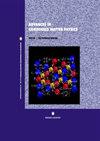Molecular Dynamics Simulation of the Coalescence and Melting Process of Cu and Ag Nanoparticles
IF 1.8
4区 物理与天体物理
Q3 PHYSICS, CONDENSED MATTER
引用次数: 0
Abstract
The coalescence and melting process of different sizes and arrangements of Ag and Cu nanoparticles is studied through the molecular dynamics (MD) method. The results show that the twin boundary or stacking fault formation and atomic diffusion of the nanoparticles play an important role in the different stages of the heating process. At the beginning of the simulation, Cu and Ag nanoparticles will contact to each other in a very short time. As the temperature goes up, Cu and Ag nanoparticles may generate stacking fault or twin boundary to stabilize the interface structure. When the temperature reaches a critical value, the atoms gain a strong ability to diffuse and eventually melt into one liquid sphere. The coalescence point and melting temperature increase as cluster diameter increases. Moreover, the arrangement of Cu and Ag nanoparticles has a certain effect on the stability of the initial joint interface, which will affect subsequent coalescence and melting behavior.Cu和Ag纳米颗粒聚结和熔化过程的分子动力学模拟
采用分子动力学方法研究了不同尺寸和排列的银、铜纳米粒子的聚结和熔化过程。结果表明,孪晶界或层错的形成和纳米粒子的原子扩散在加热过程的不同阶段起着重要作用。在模拟开始时,Cu和Ag纳米粒子会在很短的时间内相互接触。随着温度的升高,Cu和Ag纳米颗粒会产生层错或孪晶界以稳定界面结构。当温度达到一个临界值时,原子具有很强的扩散能力,并最终融化成一个液态球体。随着团簇直径的增大,聚结点和熔化温度升高。此外,Cu和Ag纳米粒子的排列对初始界面的稳定性有一定的影响,从而影响随后的聚结和熔化行为。
本文章由计算机程序翻译,如有差异,请以英文原文为准。
求助全文
约1分钟内获得全文
求助全文
来源期刊

Advances in Condensed Matter Physics
PHYSICS, CONDENSED MATTER-
CiteScore
2.30
自引率
0.00%
发文量
33
审稿时长
6-12 weeks
期刊介绍:
Advances in Condensed Matter Physics publishes articles on the experimental and theoretical study of the physics of materials in solid, liquid, amorphous, and exotic states. Papers consider the quantum, classical, and statistical mechanics of materials; their structure, dynamics, and phase transitions; and their magnetic, electronic, thermal, and optical properties.
Submission of original research, and focused review articles, is welcomed from researchers from across the entire condensed matter physics community.
 求助内容:
求助内容: 应助结果提醒方式:
应助结果提醒方式:


